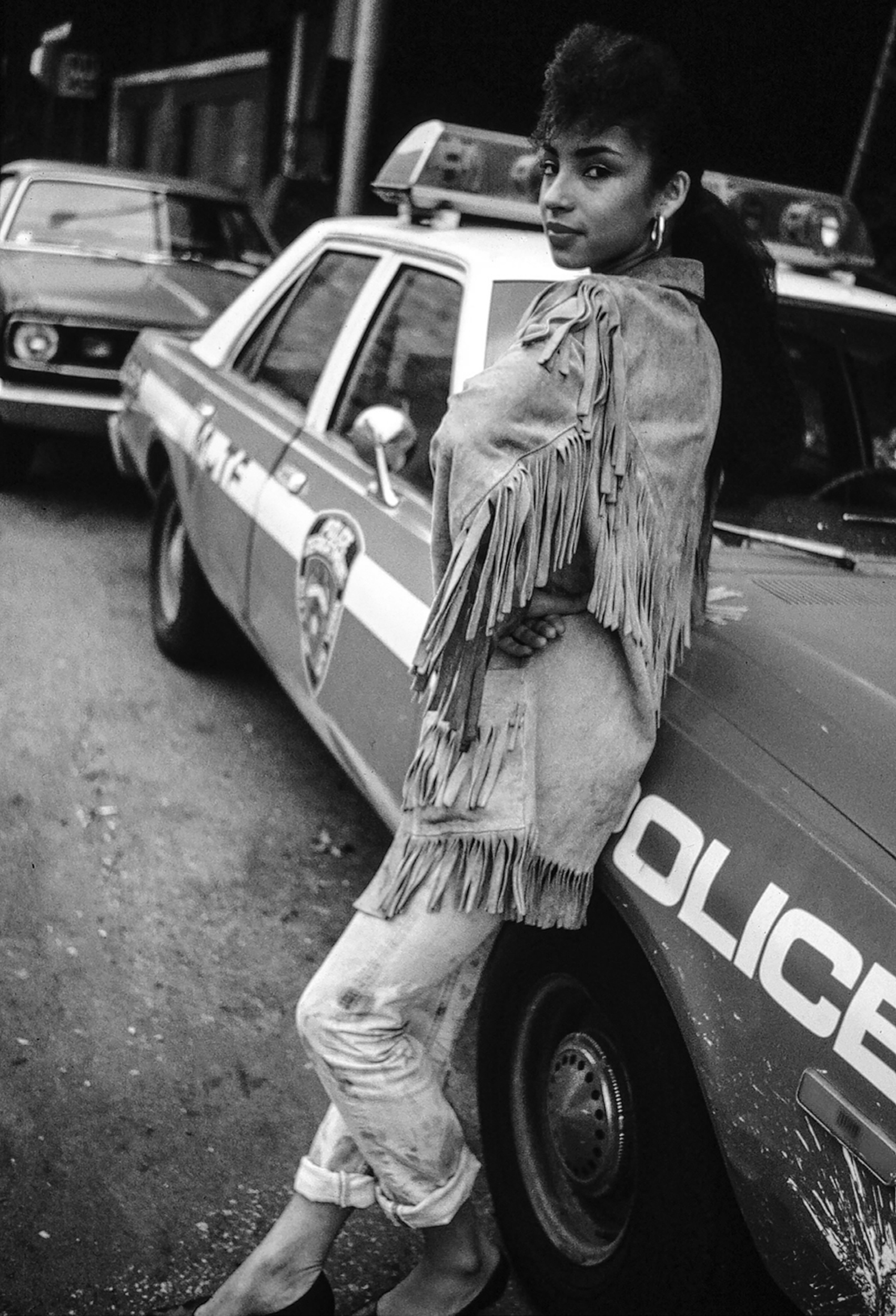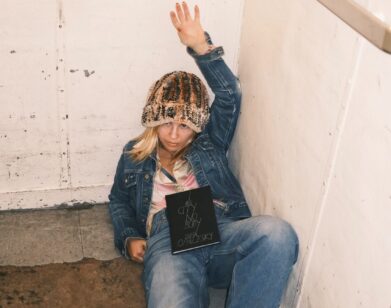gallery walkthrough
The Photographer Janette Beckman on Dragging Blondie Out of Bed
What is a rebel? Ask Janette Beckman. The British-born photographer has made the rebel spirit the focus of her new book, REBELS: From Dior to Punk (DRAGO). In her first-ever monograph, Beckman shares images captured over a four decade long career that highlight the beauty of society’s outliers in the worlds of fashion, music, art and activism. “REBELS is really about people walking their own walk, doing their own thing,” Beckman tells Interview on a recent Zoom call. “In my mind, that’s somebody like Dapper Dan, or the Harlem Dirt Bike Club, or Salt-N-Pepa.”
Beckman’s appreciation for disruptors was born of her upbringing in late ’70s and ’80s London during a time of economic, cultural, and social tumult. Her early photographs captured the frustration of London youths fed up with poverty and the British monarchy, and eventually she made her way to New York, where she spent years at Paper working alongside her friend Kim Hastreiter. It wasn’t long before Beckman became a hip hop mainstay, known for capturing a new wave of talent—in the vein of Ice Cube and Salt-N-Pepa—in their early, more intimate days. All these years later, Beckman continues to photograph “today’s rebels,” who may look and sound a bit different from the punks that came before them, but are no less determined to be heard. This week, as she readies for the opening of her new exhibition, “Rebels: From Punk to Dior,” at Fotografiska New York (Nov. 19th), the photographer took a moment to reminisce about some of her most memorable shoots—from dragging Debbie Harry out of bed, to a not-so-nice day spent with Mary J. Blige, to a cold night with Leigh Bowery.
———
MARY J. BLIGE
“I was a huge Mary J. Blige fan, and I got an assignment from a newspaper in London, The Telegraph, to photograph her. It was a cold winter’s day and she was not really in the mood to have her photograph taken and sadly, she was not the cheeriest. She was staying in a hotel by Central Park, and I persuaded her to go outside so that we could try a few poses in the park, and it just wasn’t happening. She just wasn’t feeling it. She had a group of girlfriends around her and one of them said, ‘Don’t worry about it, she’s just not in a good mood.’ So we went back to the hotel, and I’m thinking to myself, ‘This won’t work, hotel pictures are always boring.’ But we passed this wallpaper and I thought, ‘She’ll really look like a Queen here.’ You know, I grew up seeing paintings at the National Portrait Gallery in London, and I decided to make her look like 19th century royalty. So, I set my light up in the hotel corridor and we did a few shots. It was quick, and I think I got it.”
———
LEIGH BOWERY
“I have known Kim [Hastreiter] since 1982, because her best friend married my best friend. When I moved to New York, she kind of adopted me, and showed me all the cool places to go. She was like, “Me and my friend David are starting this little magazine and are going to call it Paper.” We would shoot for hours and do three or four stories for them in a night! It was really fun. They had their finger on what was going on in the downtown scene at that time. It was very different from the rest of the magazine scene, and it was great to be a part of something that was fresh. Anyways, Leigh Bowery came to the studio. He was famous in London. But he was late–it was a cold night and we were just hanging around waiting for him. He arrives and is like, ‘I’m so sorry I’m late, I just couldn’t get a taxi!’ But he’s wearing this yellow chicken costume—this big, fluffy, yellow skirt thing and an S&M mask with two light bulbs attached to each side, and these giant yellow platform shoes with white tights. I was like, ;Wow, I cannot believe a taxi wouldn’t pick you up!’ It was crazy, I love Leigh Bowery, he really was a genius.”
———
DEBBIE HARRY and CHRIS STEIN
“I took this for the cover of Melody Maker, and I went this little boutique hotel the first time that Debbie played in London. I got there really early in the morning. There was no stylist, just me knocking on the door saying, ‘I’ve come to take photos of you.’ I love this, because Debbie looks so natural. She must have just gotten out of bed. A lot of the photos of her from the ’80s, have her really made up and it’s almost too much– but here she obviously did her own hair and makeup and it’s early in the morning. A couple of years ago, I was at a Gala dinner for Gordon Parks, and sitting at my table was Debbie. I had one of my little business cards, which all have different portraits of mine on them, and I had been dying to show her the picture of her, all these years later. As she was getting up to leave, I was like, ‘Debbie, I just wanted to give you my card.’ She looked at it said, ‘That was a really great wig.'”
———
“NASTY WOMAN”
“The night Trump got elected, I was at an illegal demonstration outside Trump Tower after he became president, and I was so angry. This woman really stuck out to me. She has that deadeye stare that says, ‘I’m not going to take it anymore.’ She’s young and determined, she could be anyone. I am a huge admirer of all the photographers who documented the civil rights movement, people like Steve Shapiro. Obviously, I was too young to be part of that, but this to me seems to have some of that energy.”
———
ICE CUBE
“I took this photograph when I was doing my very first book about hip hop in 1991. It’s called Rap! Portraits and Lyrics of a Generation of Black Rockers, and I did it with a writer called Bill Adler, who formerly did PR for Def Jam. We had so many pictures of New York rappers and I thought it was really important to include the West Coast, so I took a trip out west and connected with N.W.A. Ice Cube had just left the band at that time. One day, I went to photograph N.W.A. at their studio—they’d just released “Fuck tha Police,” which was obviously a huge thing, and I got a shot of them standing in front of a police car that I had just flagged down on the street. That same afternoon, I went over to Ice Cube’s mom’s house. This is a picture of him sitting on her porch. I also took some of him with his mom, and you can see how proud she is of him– there was so much love between them, it was really a beautiful thing to see. I love this one. He’s got a raiders hat on, and he’s fierce.”
———
SALT-N-PEPA
“Salt-n-Pepa, my girls. I met them before they even had a record contract. I took this shot for a British magazine, and we had spent the day hanging on the Lower East Side. They said, “You’re nice, will you be our record photographer?” I took a bunch of pictures of them for their first album. That’s when “Push It” and their huge hits were coming out. They arrived at my studio on the day we took this picture, and the amazing thing was they were already dressed like that. I reached out to Salt for a quote when we were making the book. To me, they changed the face of hip hop, because before them, it was a very male-dominated genre. Here’s what she said: ‘How could anyone have known that this would be one of the most recognizable, iconic photos in music history? Janette made this intensely powerful, superwoman fashion statement, and captured the essence of who we were at that moment–young, vibrant women on a mission to conquer this male-dominated genre of music called hip hop–mission accomplished.’ I mean, it’s pure female power. I love this one so much. It’s one of my favorite pictures I’ve ever taken. They felt so free to express themselves in front of me. I did quite a few of their album covers after this.”
———
SADE
“This is a personal favorite of mine as well. I shot this photo on Pitt Street on the Lower East Side, when Sade was actually in a band called Pride. It’s just a moment in time, where she’s leaning against a cop car, and she looks so beautiful. Pride was an amazing band. I think a couple of the members went on to play with her later. I remember the concert that night got a little bit rowdy, and she just stood up and said, ‘Are you going to listen to me?’ And everybody just shut up. You know, it was a rowdy Lower East Side crowd in 1983. She started singing and right then I knew she was going to be big. She has such a beautiful voice, and was wearing this long black dress, and I thought, ‘this woman.’“
———
LONDON PUNKS
“A bunch of punks sitting on a bench outside the town hall at Kings Road. That’s what they used to do every Saturday and Sunday–they would get together on this particular bench outside of town hall. Kings Road was the fashion parade of London during the punk era. Everybody would hang out there, just yelling and drinking beer or whatever. I would go down there most weekends just to see what was going on, and see how people looked. The funny thing is, I’m in touch with the daughters of two of these women! Due to the wonders of Instagram, they saw the photo and contacted me saying, ‘That’s my mom in that picture!’ That is so fabulous. I sent them prints, and we have this relationship now– it’s a really beautiful thing, all these years later.”
“This was at the memorial march for Sid Vicious, when he died. We all gathered in Victoria and marched to Hyde Park– it was massive, there were thousands of punks there. There were tons of cops there, but you know, there was no fighting. Everyone was just so sad. People had black armbands with his name on them. They all came out to celebrate Sid, who sadly, as we all know, had died from an overdose.”
———
JOAN JETT
“I shot in this in New York City at a benefit for the Ramones. There were a lot of great bands playing, but Joan Jett came out, and I had never seen her before. It’s such a rock picture, so much female power. Being right underneath her was pretty incredible. She’s very raw and amazing.”
















